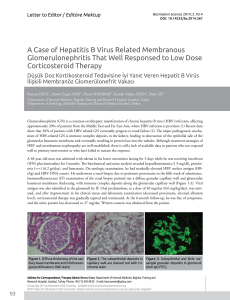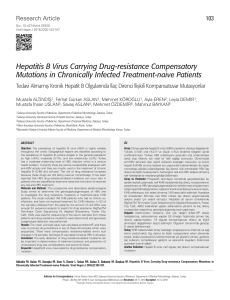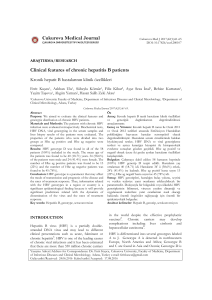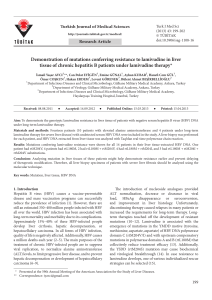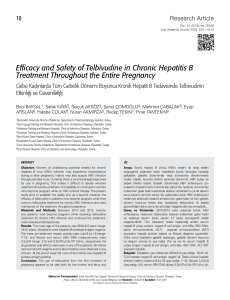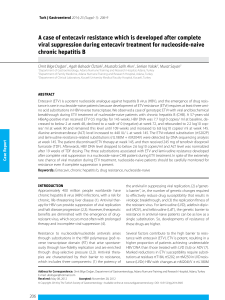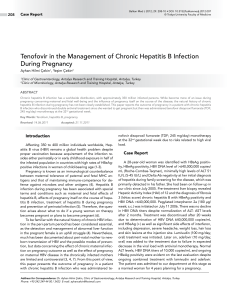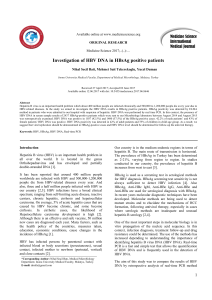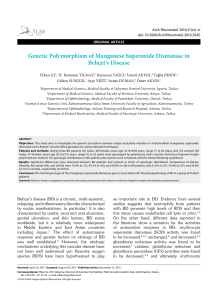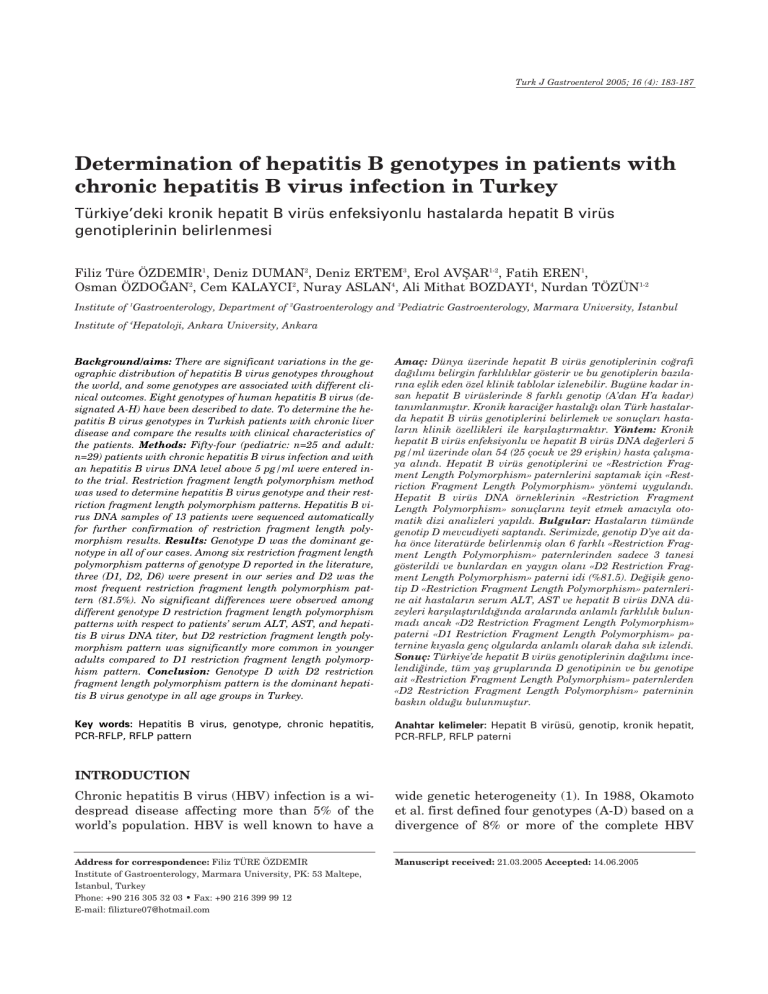
Turk J Gastroenterol 2005; 16 (4): 183-187
Determination of hepatitis B genotypes in patients with
chronic hepatitis B virus infection in Turkey
Türkiye’deki kronik hepatit B virüs enfeksiyonlu hastalarda hepatit B virüs
genotiplerinin belirlenmesi
Filiz Türe ÖZDEM‹R1, Deniz DUMAN2, Deniz ERTEM3, Erol AVfiAR1-2, Fatih EREN1,
Osman ÖZDO⁄AN2, Cem KALAYCI2, Nuray ASLAN4, Ali Mithat BOZDAYI4, Nurdan TÖZÜN1-2
Institute of 1Gastroenterology, Department of 2Gastroenterology and 3Pediatric Gastroenterology, Marmara University, ‹stanbul
Institute of 4Hepatoloji, Ankara University, Ankara
Background/aims: There are significant variations in the geographic distribution of hepatitis B virus genotypes throughout
the world, and some genotypes are associated with different clinical outcomes. Eight genotypes of human hepatitis B virus (designated A-H) have been described to date. To determine the hepatitis B virus genotypes in Turkish patients with chronic liver
disease and compare the results with clinical characteristics of
the patients. Methods: Fifty-four (pediatric: n=25 and adult:
n=29) patients with chronic hepatitis B virus infection and with
an hepatitis B virus DNA level above 5 pg/ml were entered into the trial. Restriction fragment length polymorphism method
was used to determine hepatitis B virus genotype and their restriction fragment length polymorphism patterns. Hepatitis B virus DNA samples of 13 patients were sequenced automatically
for further confirmation of restriction fragment length polymorphism results. Results: Genotype D was the dominant genotype in all of our cases. Among six restriction fragment length
polymorphism patterns of genotype D reported in the literature,
three (D1, D2, D6) were present in our series and D2 was the
most frequent restriction fragment length polymorphism pattern (81.5%). No significant differences were observed among
different genotype D restriction fragment length polymorphism
patterns with respect to patients’ serum ALT, AST, and hepatitis B virus DNA titer, but D2 restriction fragment length polymorphism pattern was significantly more common in younger
adults compared to D1 restriction fragment length polymorphism pattern. Conclusion: Genotype D with D2 restriction
fragment length polymorphism pattern is the dominant hepatitis B virus genotype in all age groups in Turkey.
Amaç: Dünya üzerinde hepatit B virüs genotiplerinin co¤rafi
da¤›l›m› belirgin farkl›l›klar gösterir ve bu genotiplerin baz›lar›na efllik eden özel klinik tablolar izlenebilir. Bugüne kadar insan hepatit B virüslerinde 8 farkl› genotip (A’dan H’a kadar)
tan›mlanm›flt›r. Kronik karaci¤er hastal›¤› olan Türk hastalarda hepatit B virüs genotiplerini belirlemek ve sonuçlar› hastalar›n klinik özellikleri ile karfl›laflt›rmakt›r. Yöntem: Kronik
hepatit B virüs enfeksiyonlu ve hepatit B virüs DNA de¤erleri 5
pg/ml üzerinde olan 54 (25 çocuk ve 29 eriflkin) hasta çal›flmaya al›nd›. Hepatit B virüs genotiplerini ve «Restriction Fragment Length Polymorphism» paternlerini saptamak için «Restriction Fragment Length Polymorphism» yöntemi uyguland›.
Hepatit B virüs DNA örneklerinin «Restriction Fragment
Length Polymorphism» sonuçlar›n› teyit etmek amac›yla otomatik dizi analizleri yap›ld›. Bulgular: Hastalar›n tümünde
genotip D mevcudiyeti saptand›. Serimizde, genotip D’ye ait daha önce literatürde belirlenmifl olan 6 farkl› «Restriction Fragment Length Polymorphism» paternlerinden sadece 3 tanesi
gösterildi ve bunlardan en yayg›n olan› «D2 Restriction Fragment Length Polymorphism» paterni idi (%81.5). De¤iflik genotip D «Restriction Fragment Length Polymorphism» paternlerine ait hastalar›n serum ALT, AST ve hepatit B virüs DNA düzeyleri karfl›laflt›r›ld›¤›nda aralar›nda anlaml› farkl›l›k bulunmad› ancak «D2 Restriction Fragment Length Polymorphism»
paterni «D1 Restriction Fragment Length Polymorphism» paternine k›yasla genç olgularda anlaml› olarak daha s›k izlendi.
Sonuç: Türkiye’de hepatit B virüs genotiplerinin da¤›l›m› incelendi¤inde, tüm yafl gruplar›nda D genotipinin ve bu genotipe
ait «Restriction Fragment Length Polymorphism» paternlerden
«D2 Restriction Fragment Length Polymorphism» paterninin
bask›n oldu¤u bulunmufltur.
Key words: Hepatitis B virus, genotype, chronic hepatitis,
PCR-RFLP, RFLP pattern
Anahtar kelimeler: Hepatit B virüsü, genotip, kronik hepatit,
PCR-RFLP, RFLP paterni
INTRODUCTION
Chronic hepatitis B virus (HBV) infection is a widespread disease affecting more than 5% of the
world’s population. HBV is well known to have a
wide genetic heterogeneity (1). In 1988, Okamoto
et al. first defined four genotypes (A-D) based on a
divergence of 8% or more of the complete HBV
Address for correspondence: Filiz TÜRE ÖZDEM‹R
Institute of Gastroenterology, Marmara University, PK: 53 Maltepe,
‹stanbul, Turkey
Phone: +90 216 305 32 03 • Fax: +90 216 399 99 12
E-mail: filizture07@hotmail.com
Manuscript received: 21.03.2005 Accepted: 14.06.2005
184
ÖZDEM‹R et al.
genome (2). In 1992, Norder et al. compared S-gene sequences of the HBV genomes formerly classified by Okamoto and they showed that the smallest differences of S gene sequences between genomes were 4.1%. Thereafter, two new genotypes designated as E and F were defined using at least 4%
differences at the level of S-gene (3), followed by G
and H recently reported from Belgium and Central America (4,5). Thus, eight genotypes of HBV
(A-H) in total have been defined to date.
Genotype A prevails mainly in North America,
northern Europe, India, and Africa; genotype B
and C in Asia; genotype D in southern Europe, the
Middle East, and India; genotype E in West and
South Africa; genotype F in South and Central
America; genotype G in the United States and Europe; and genotype H in Central America and California (6).
HBV genotypes may have different pathogenesis
according to their geographic distribution and
they seem to play a role in disease behavior and
outcome. Various studies have found an association between genotypes and disease severity as well
as response to antiviral treatment (7-9).
The well-known variations in HBV genotype in
different geographic areas of the world prompted
us to investigate the situation in the Turkish population, especially in groups of children, which
has been under-reported when compared to
adults, and the correlation of the genotype with disease characteristics.
MATERIALS AND METHODS
Fifty-four patients with HBV DNA levels greater
than 5 pg/ml as determined using a commercially
available liquid-hybridization assay (Digene,
USA) were studied. The study protocol was approved by the local ethics committee and informed
consent was obtained from each adult patient and
parents of the pediatric patients. There were 36
males and 18 females, aged 2 to 65. All patients
were seronegative for hepatitis C virus.
HBV DNA was extracted from the serum samples
by the standard methods and genotypes were determined by polymerase chain reaction-restriction
fragment length polymorphism (PCR-RFLP). Serum samples were stored at -80°C until studied.
The segment of the HBV genome between nt 256
and 796 was amplified for genotyping. Sera were
prepared with NaOH as previously described (10)
or with proteinase K, phenol/chloroform method.
Ten microliters of the mixture from either
preparation was used for PCR in a reaction volume of
50 µl (11). Primers were sense:
5’GTGGTGGACTTCTCTCAATTTTC, and antisense: 5’CGGTA(A/T)AAAGGGACTCA(A/C)AT.
After an initial 3 min denaturation at 94°C, 40
cycles of amplification, including denaturation for
45 s at 94°C, annealing for 60 s at 53°C and extension for 90 s at 72°C were done and followed by a
final 7 min extension at 72°C. Samples of DNA
were run on 1% standard agarose gel.
PCR product (10 µl) was mixed with 1 µl (5U) of
Tsp EI (MBI Fermentas), 1.5 µl of 10X buffer and
2.5 µl of water and then incubated at 65°C for 3 h.
In a separate reaction, PCR product (10 µl) was
mixed with 0.5 µl (5U) of HinfI (MBI Fermentas),
1.5 µl of 10X buffer and 3 µl of water and incubated at 37°C for 3 h. After incubation, the samples
were run on a mixed gel containing 2% NuSieve
agarose (MBI Fermentas) and 1% standard agarose. DNA was visualized by ethidium bromide staining. The restriction patterns were read visually
(11) (Table 1).
Differences of S gene nucleotides (nt 256-296) between patterns were determined by automatic
Table 1. Restriction points of enzymes
Ptn.
Restriction points with
HinfI*
379 481 529 614 633
D1
526 15
D2
D6
Length of bp
X
X
274 252 15
X
252 226 48 15
*Number of nucleotides, Ptn: Pattern, bp: Base pairs
Restriction points with
Tsp*
354 480 589 633 686
X
X
X
X
X
X
X
X
Length of bp
173
164
109
43
36
16
173
164
109
43
36
16
282
164
43
36
16
185
Hepatitis B virus genotypes in Turkey
DNA sequencer (ABI 310 system, Perken Elmer,
USA). The nucleotide sequences of each pattern
were obtained from the literature and confirmed
by comparing the specific sequences in gene bank.
Phylogenetic comparison was done by distance
matrix/UPGMA analysis using Kimura 2-parameter by MEGA2 software package program (Figure
1) (12).
D20084
D20563
D20027
Statistical Analysis
Student's t-test was used for the comparison of means within groups. Correlation between continuous variables was analyzed using Spearman's test.
P values less than .05 were considered significant.
RESULTS
Overall 25 pediatric (16 male, 9 female) and 29
adult (20 male, 9 female) patients were enrolled
into the study. The mean ages of children and
adults were 8.6 ± 3.46 (2-17) years and 39.2 ±
13.83 (20-65) years, respectively. Demographic
and clinical data are summarized in (Table 2).
D60433
D60032
M32138
D20936
D20328
X65257
D20291
D10373
D60697
X68292
D
J02203
Z35716
X75664
E
X75657
D50489
C
D23682
X04615
Table 2. Demographic and biochemical data of chronic
hepatitis B patients
Characteristic
Age (year)
Sex (F/M)
ALT (U/L)
AST (U/L)
ALP (U/L)
GGT (U/L)
Total protein (g/dl)
Albumin (g/dl)
AB064312
G
AF160501
AB056515
V00866
HBV DNA
(pg/ml)
Children
8.88±3.7
(2-18)
9/16
77.8±51.57
(15-224)
104.56±63.66
(15-256)
369.83±209.49
(119-1000)
24.75±35.3
(7-171)
7.13±0.53
(6.1-8.2)
4.06±0.31
(3.4-4.5)
3026.44±1463.53
(79-5008)
Adults
40±14.12
(20-65)
9/20
121.75±116.46
(35-549)
95.21±95.4
(21-475)
167.19±80.43
(44-375)
41.75±16.85
(12-72)
7.6±1.19
(3.7-8.6)
4.13±0.77
(1.8-5)
2421.7±1884.6
(7-7972)
Data presented as mean±SD (range) or number of patients
L13994
A
X51970
S50225
D23678
B
D23679
D00331
D00330
X75663
X75658
F
X69798
H
AY090460
AY090454
AY090457
0.01
Figure 1. Phylogenetic tree obtained by distance matrix/UPGMA comparison (with Kimura-2 correction) after bootstrapping
1000 replicates of sequence segment from the S region of HBV
(nt 468-718), (D20084, D20563, D20027, D60433, D60032,
D20936, D20328, D20291, D10373, D60697 are our patients,
the others are from the gene bank). RFLP: Restriction fragment
length polymorphism
All patients were HBsAg positive. HBeAg positivity was more prevalent in children than adults
(24/25 vs 10/29, respectively) (p<0.001). Furthermore, children had significantly higher HBV DNA
values than adults [3026.44±1463.53 (79-5880) vs.
2421.7±1884.6 (7-7972) pg/ml; p=0.03]. Thirty-four of 54 patients had a liver biopsy and 30 had
chronic hepatitis and two had cirrhosis. Sixteen
out of 34 cases were children. In 24 of 54 patients
(44.44%), there was a family history of HBV infection.
Regarding HBV genotypes, genotype D was predominant in all of our patients. Among six different
RFLP patterns of genotype D described in the literature, only D1, D2 and D6 were observed in our
study, and D2 was the most frequent RFLP pattern. There was no significant dissociation among
RFLP patterns in adults and children apart from
186
ÖZDEM‹R et al.
D6, which was only found in adults (Table 3). D2
RFLP pattern was more common in younger patients compared with D1 (D2, 36.7±14.2 years vs.
D1, 53.2±9.6 years, p=0.028), but no significant
differences were observed among different genotype D RFLP patterns with respect to patients’ serum ALT, AST, HBV DNA titer, HBeAg status
and histologic data.
Table 3. Dissociation of patterns
RFLP Patterns of Genotype D
Group
D1 (%)
D2 (%)
Adult
5
21
Children
2
23
Total
7 (13)
44 (81.5)
D6 (%)
3
3 (5.5)
Total
29
25
54
When the past medical histories of the patients
were reviewed, six of 14 children who received interferon (IFN)-α had no response to treatment and
seven of 18 adults who received IFN-α experienced
a relapse and were switched to lamivudine therapy by the time the current study was conducted.
DISCUSSION
We found that a single genotype, namely genotype
D, was prevalent in the entire study population.
Most common RFLP patterns were D1, D2 and D6.
This is the first study evidencing HBV genotypes
in children and also demonstrating those three
RFLP patterns of genotype D in Turkey.
Sequencing of viral genomes has become a major
goal of descriptive virology, and the data is used to
trace routes of infection, to reconstruct the phylogenetic history of viruses and to delineate genetic
subtypes. HBV is a typical example of a virus that
attracts attention with its different genotypes,
showing special geographic distribution around
the world. A genetic classification based on the
comparison of complete genomes has defined eight
genotypes of HBV, which were designated from A
through H (6).
Genotype D appears to predominate in the Mediterranean basin and the Middle East, and this is
consistent with Turkey’s geographical location in
the world as a bridge between Southeast Europe
and Asia. Our findings are consistent with the previous data from Turkey (13-16).
In our study, there was a family history of HBV infection in 44.4% of all patients. Recent data supported that the transmission was more likely to be
via horizontal route in patients infected with genotype D in France, where genotypes A and D were more prevalent (17). In contrast, in the United
States, genotype D was related to all modes of infection (18).
In the current study, as might be expected, almost
all of our pediatric patients were positive for HBeAg. However, the majority of our adult patients
were anti-HBe positive. Similarly, in French patients, genotype D was predominant in anti-HBepositive patients with chronic hepatitis (16).
Genotype D was reported to be associated with a
poor response to antiviral therapy (9). In our series, it was not possible to comment about the effect
of genotype on the response to antiviral treatment
since this was not a longitudinal study.
Lindh et al. were able to show different RFLP patterns of genotypes in their series using computer
analysis, but they could not explain the correlations between these patterns and clinical outcomes
(11). In our study, no significant correlation was
found between genotype D RFLP patterns and liver function tests, the presence of cirrhosis, clinical course, HBeAg and anti-HBe status and the viral load; however, the number of patients for each
pattern was insufficient to reach firm conclusions.
In conclusion, genotype D with D2 RFLP pattern
is the dominant HBV genotype in Turkey in all
age groups. Further studies in patients chronically infected with HBV are warranted to delineate the influences of different genotype D RFLP
patterns on the disease behavior and response to
antiviral therapy in our country.
ACKNOWLEDGEMENTS
This study was supported by grants from the Marmara University Research Fund.
REFERENCES
1. Blumberg BS, Alter HJ, Visnich S. A new antigen in leukemia sera. JAMA 1965; 191: 541.
2. Okamoto H, Tsuda F, Sakugawa H, et al. Typing hepatitis
B virus by homology in nucleotide sequence: Comparison of
surface antigen subtypes. J Gen Virol 1988; 69: 2575-83.
3. Norder H, Hammas B, Löfdahl S, et al. Comparison of the
amino acid sequences of nine different serotypes of hepatitis B surface antigen and genomic classification of the corresponding hepatitis B virus strains. J Gen Virol 1992; 73:
1201-8.
Hepatitis B virus genotypes in Turkey
4. Stuyver L, De Gendt S, Van Geyt C, et al. A new genotype
of hepatitis B virus: Complete genome and phylogenetic relatedness. J Gen Virol 2000; 81: 67-74.
5. Arauz-Ruiz P, Norder H, Robertson BH, et al. Genotypes
H: a new Amerindian genotype of hepatitis B virus revealed in Central America. J Gen Virol 2002; 83: 2059-73.
6. Keeffe EB, Dieterich DT, Han SHB, et al. A treatment algorithm for the management of chronic hepatitis B virus
infection in the United States. Clin Gastroenterol Hepatol
2004; 2(2): 87-106.
7. Kao JH, Chen PJ, Lai MY, et al. Hepatitis B genotypes correlate with clinical outcomes in patients with chronic hepatitis B. Gastroenterology 2000; 118: 554-9.
8. Chu CJ, Lok AS. Clinical significance of hepatitis B virus
genotypes. Hepatology 2002; 35: 1274-6.
9. Conjeevaram HS, Lok ASF. Management of chronic hepatitis B. J Hepatology 2003; 38: 90-103.
10. Lok ASF, Akarca U, Greene S. Mutations in the precore region of hepatitis B virus serve to enhance the stability of
the secondary structure of the pre-genome encapsidation
signal. Proc Natl Acad Sci 1994; 91: 4077-81.
11. Lindh M, Andersson AS, Gusdal A. Genotypes, nt 1858 variants, and geographic origin of hepatitis B virus- largescale analysis using a new genotyping method. J Inf Dis
1997; 175: 1285-93.
187
12. Kumar S, Tamura K, Jakobsen IB, et al. MEGA2: molecular evolutionary genetics analysis software. Bioinformatics
2001; 17: 1244-5.
13. Bozday› AM, Bozkaya H, Uzunalimoglu O, et al. Nucleotide divergences in the core promoter and precore region of
genotype D hepatitis B virus in patients with persistently
elevated or normal ALT levels. J Clin Virol 2001; 21: 91101.
14. Bozday› AM, Aslan N, Bozday› G, et al. Molecular epidemiology of hepatitis B, C and D viruses in Turkish patients.
Arch Virol 2004; 149(11): 2115-29.
15. Yalc›n K, Degertekin H, Bahcecioglu IH, et al. Hepatitis B
virus genotype D prevails in patients with persistently elevated or normal ALT levels in Turkey. Infection 2004; 32:
24-9.
16. Leblebicioglu H, Eroglu C, Members of the Hepatitis Study
Group. Acute hepatitis B virus infection in Turkey: epidemiology and genotype distribution. Clin Microbiol Infect
2004; 10(6): 537-41.
17. Grandjacques C, Pradat P, Stuyver L, et al. Rapid detection of genotypes and mutations in the pre-core promoter
and the pre-core region of hepatitis B virus genome: Correlation with viral persistence and disease severity. J Hepatology 2000; 33: 430-9.
18. Chu CJ, Kneeffe EB, Han SH, et al. Hepatitis B virus genotypes in the United States: Results of a Nationwide
Study. Gastroenterology 2003; 125: 444-51.

